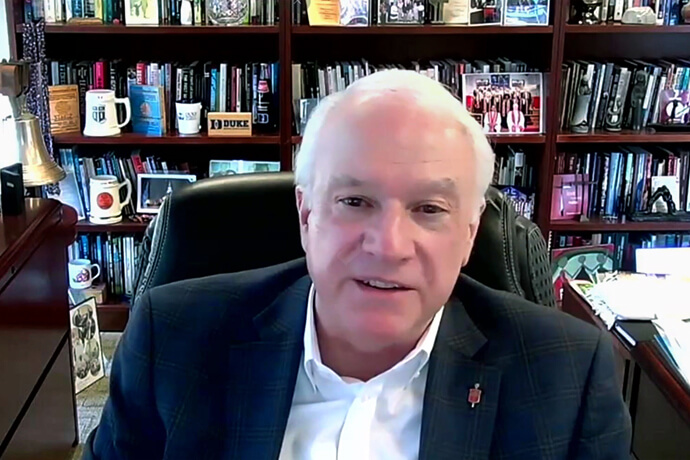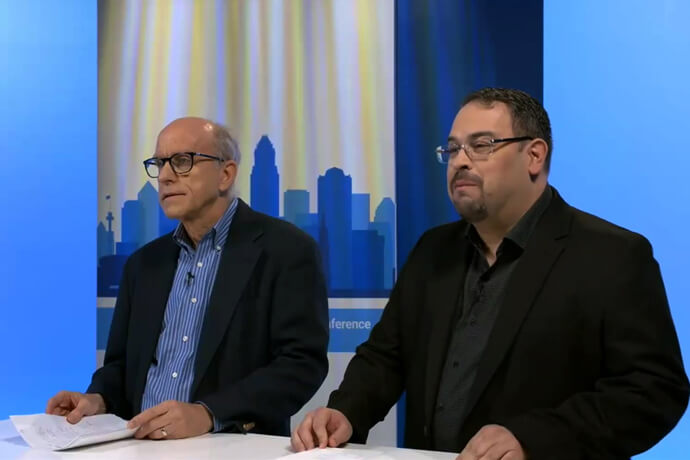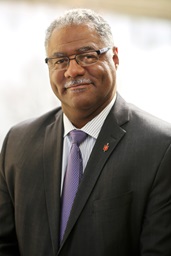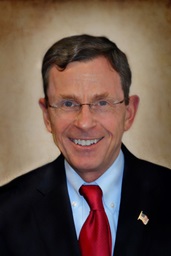Key Points:
- Legislation coming before General Conference deals with matters as varied as the denomination’s international structure, social witness, ecumenical relations and budget.
- An online briefing gave delegates and other observers a preview of some of the proposals heading to The United Methodist Church’s top policymaking assembly.
- Council of Bishops President Thomas J. Bickerton urged delegates to let go of old ways and help the denomination move forward beyond its current challenges.
After tough years of dealing with disease and departures, United Methodists are about to gather for a General Conference that will chart the denomination’s future.
More than 1,000 legislative petitions aiming to shape that future will be before the lay and clergy delegates when they meet for the denomination’s COVID-delayed policymaking assembly on April 23-May 3 in Charlotte, North Carolina.
The theme for the international gathering, which draws delegates and other church leaders from four continents, will be “…and know that I am God” from Psalm 46.
“We find ourselves at a seminal moment in the life of this denomination. It’s a marker point, a shift, a pivot from what was to what can be,” Council of Bishops President Thomas J. Bickerton told delegates and other observers.
The bishop, who also leads the New York Conference, spoke at the end of the Feb. 29-March 1 online orientation co-hosted hosted by United Methodist Communications and the Rev. Gary Graves, General Conference secretary.
At the briefing, Bickerton and other speakers addressed United Methodists still feeling the impact of the COVID pandemic and church disaffiliations.
Bickerton said the church can only move forward.
“Personally, I don’t want to go back to mediocrity and old habits,” said the bishop, who attended his first General Conference in 1984. “I don’t want to go back to racist behaviors, gender bias or models that exclude rather than welcome. This is a moment for us to get a new wind and a new sense of purpose.”
During the orientation, which was also recorded, viewers received an overview of the logistics of General Conference as well as legislation up for the delegates’ votes.
This second of two stories looks at some of those proposals.

Regionalization
The most far-reaching proposals facing delegates involve what many United Methodists call regionalization.
Regionalization would restructure the denomination with the goal of putting on equal footing the church in the U.S. and the seven central conferences in Africa, Europe and the Philippines.
Currently, central conferences have authority under the denomination’s constitution to make “such changes and adaptations” to the Book of Discipline — the denomination’s policy book — as missional needs and differing legal contexts require.
That leaves General Conference treating the U.S. as the default and spending much of its time on matters that only affect the U.S., including U.S.-only retirement plans. To get General Conference focused on matters that affect the entire denomination, many church leaders have come to believe that the U.S. needs a place to do its own work.
With this all in mind, the Connectional Table — a leadership body that coordinates denomination-wide ministries — submitted a plan to create a U.S. Regional Conference to handle U.S.-centric church issues. Wespath, the denomination’s pension and benefits agency, collaborated on the legislation to help vet any legal or administrative issues.
Building on the Connectional Table’s work, a group of United Methodists in the Philippines, Africa and Europe created the Christmas Covenant. Under that legislation, not only the U.S. but also all central conferences become regional conferences.
The Standing Committee on Central Conference Matters — a permanent General Conference committee with a majority of members from central conferences — built on this earlier work and submitted the most recent plan, Worldwide Regionalization. The standing committee worked with both the Connectional Table and Christmas Covenant developers in drafting its legislation.
The Connectional Table and most of the Christmas Covenant team have endorsed the standing committee’s legislation, which spells out in detail what authority the regions would have. Both the Christmas Covenant and Worldwide Regionalization incorporate the Connectional Table’s original legislation in its entirety.
Under the plan, each United Methodist regional conference would have the same duties and powers to pass legislation for greater missional impact in their respective regions.
“Is regionalization a new thing in The United Methodist Church? It is not,” said Dr. Kasongo Peniel, a standing committee member from the Congo Central Conference. He was among the standing committee members who helped draft Worldwide Regionalization.
“These petitions that we are offering to the General Conference for you to act upon would give to the United States of America the same power that the central conferences have got around the world,” he said. “Then it will help the church to make General Conference more efficient, more focused on what is global, more focused on the mission of the church.”
Judi Kenaston, the Connectional Table’s chief connectional officer and delegate from West Virginia, addressed a common question about regionalization: What does it mean for the denomination’s longtime debate over the place of LGBTQ people in church life?
She noted that as written, regionalization does not change the denomination’s current bans on same-sex weddings and “self-avowed practicing” gay clergy.
Regionalization would allow each region to set qualifications for clergy. It also would allow each region to determine what it considers chargeable offenses under church law. Any regional conference policy would need to be in line with the laws of the country or countries within its borders.
“The goal of contextualization is to allow for laws of a certain area and not allow decisions from one region to influence or dominate the other,” Kenaston said.
During the first week of General Conference, delegates meet in legislative committees to determine what makes it to the plenary floor. Currently, all the petitions dealing with regionalization are assigned to the conferences committee.
But because regionalization has the potential to affect other legislation, the General Conference commission has set aside time for all legislative committees to discuss what regionalization might mean for their work.
All regionalization proposals require amending the denomination’s constitution — a high bar. For ratification, amendments must receive at least a two-thirds vote at General Conference and at least two-thirds of the total votes from annual conferences, church bodies consisting of voters from multiple congregations.

General Book of Discipline
Adding to the urgency for regionalization is the work the standing committee began in 2012 to determine what in the Book of Discipline’s Part VI applies to all regions and what they can adapt.
Part VI, the Discipline’s largest section, deals with organization and administration. The standing committee has been collaborating with other United Methodist leadership bodies to draft a proposed General Book of Discipline that would contain only the portions that apply to the entire church and thus require General Conference action to change.
That work remains ongoing. But the standing committee is asking annual conferences around the globe to provide feedback on the work done so far. The standing committee is also asking General Conference’s permission to be able to add and delete words in existing disciplinary provisions in drafting its proposal for a General Discipline. The teams working on the General Discipline found the current disciplinary wording too U.S.-centric and wants to use terms that do not favor one culture over another.
Whatever happens with regionalization and the work on the General Discipline, there will be parts of the Discipline that will continue to apply to all United Methodists. That includes the denomination’s doctrinal standards, its constitution, its views on the ministry of all Christians and its Social Principles, which contain the denomination’s social witness.
Revised Social Principles
Going back to John Wesley’s public support for laborers and opposition to slavery, the people called Methodist have drawn on their faith to take stands on the issues of their day.
More about proposals
The Feb. 29-March 1 delegate orientation touched on more legislation than included here.
Over the two days of the orientation, more than 500 delegates tuned in via Zoom while at various points more than 1,300 others watched the livestream. In total, viewers came from 30 countries.
The orientation was recorded. People can view the schedule and watch the sessions they are interested in at their convenience.
People can also view the petitions before delegates in the Advance Daily Christian Advocate, which is available in PDF form.
That tradition has continued through Methodism’s first Social Creed in 1908 to today’s Social Principles.
General Conference is the only body that can amend this part of the Discipline. But delegates this year will have the chance to vote on a whole slate of Revised Social Principles submitted by the United Methodist Board of Church and Society.
The revision process began when the 2012 General Conference approved a petition from the three central conferences in Europe to make the Social Principles “more globally relevant, theologically founded and succinct.”
The following multiyear revision process involved thousands of United Methodists around the world. Church and Society began the work with listening sessions in Africa, Europe, the Philippines and the United States. The agency then turned to a writing team of 52 United Methodists from the same four continents to draft the revisions.
More than 4,000 United Methodists read, reviewed and commented on the first Social Principles draft.
Their feedback contributed to the resulting petitions, which share church teachings on matters as diverse as poverty, climate change, immigration, substance abuse and colonialism.
“This has been just an amazing journey involving so many voices in a way that we believe really reflects who we are as United Methodists today,” said John Hill, Church and Society’s interim top executive.
He added that the revision “gives us a strong social statement for who we are to be as we move forward out of General Conference.”
Acts of Repentance
Even as they make decisions about the church’s future, delegates will have an opportunity to repent of harms from the church’s past.
Back when the #MeToo movement was in the news, the Council of Bishops and Commission on the Status and Role of Women jointly announced that they “strongly encourage and support the reporting of sexual misconduct, including sexual harassment allegations within the church.”
Now the Status and Role of Women commission is hoping to go a step further. The agency has submitted a petition asking the church to apologize to victims of sexual misconduct in the church. The petition also asks each annual conference to likewise issue a public apology.
The commission also plans to have a vigil for sexual-misconduct victims during General Conference.
An apology “is the first step that is necessary for healing,” said Dawn Wiggins Hare, top executive of the Status and Role of Women commission.
Her agency has a long history of helping victims of abuse in the church, and she said the idea for the petition came about from discussions with victims who called the agency’s office,
“Nobody had ever said, ‘I’m just sorry. I am so sorry for what happened to you and it interfered with your relationship with Christ and with the church,’” Hare said.
The California-Pacific Conference has submitted legislation asking the church to address another past injustice. The conference, which includes Hawaii, seeks a formal apology to native Hawaiians for the overthrow of the Kingdom of Hawaii in 1893.
Other denominations and the U.S. government already have issued such apologies. United Methodists also have a personal stake in what happened, said the Rev. Giovanni Arroyo, the top executive of the United Methodist Commission on Religion and Race.
One of the supporters of the kingdom’s overthrow by U.S. naval and marine forces was the Rev. Harcourt Peck, a sharpshooter who later became pastor of First Methodist Episcopal Church in Hawaii.
“This petition first acknowledges the sin of racism and colonial realities that occurred in the overthrow and it invites the church to write a formal apology,” Arroyo said.
“But that apology must be done with a task force that invites people from the native Hawaiian community to share their perspective.”
During the 2012 General Conference, United Methodists engaged in an “Act of Repentance toward Healing Relationships with Indigenous Peoples.” The service was the first in series of steps United Methodists have taken to address past injustices against native peoples.

Amendments for equality
Both the Status and Role of Women and the Religion and Race commissions have submitted amendments to the denomination’s constitution.
Status and Role of Women continues its 20-year effort to add “gender” to Paragraph 4 of the constitution, which says people are eligible for United Methodist membership regardless of race, color, national origin, status or economic condition.
The effort to add “gender” to the non-discrimination list passed General Conference in 2016, but fell short of the necessary annual conference votes for ratification.
It’s important because membership is key to becoming a leader in The United Methodist Church, Hare said.
“So, we wanted to assure at all United Methodist churches across the connection that no one would be denied membership on the basis of their gender,” she added.
Religion and Race has submitted an amendment to the constitution’s Paragraph 5 to strengthen the denomination’s stance for racial justice.
“We are naming the reality of white supremacy and colonialism that is being fueled in our society,” Arroyo said, “and we are calling the church to be more responsible in dismantling and addressing this sin of racism.”
Separations and disaffiliations
Back when no one had heard of COVID-19 and United Methodists expected to hold General Conference in 2020, the legislative proposals getting all the buzz involved separating the denomination along theological lines.
Each of those proposals is still before delegates. The plans include the New Denominations of United Methodism, New Expressions Worldwide, Next Generation UMC and the negotiated Protocol of Reconciliation and Grace Through Separation. Ultimately, the delegates will need to decide how they want to handle those petitions.
In the meantime as General Conference has been delayed, a separation of sorts already has taken place.
Over the past four years, the denomination has seen nearly 7,700 U.S. churches — about a quarter of its U.S. congregations — disaffiliate under a policy approved by the 2019 special General Conference that expired at the end of 2023.
That policy, the Discipline’s Paragraph 2553, allowed churches to leave with property “for reasons of conscience” related to homosexuality, if they met certain financial and procedural obligations. Because of action taken by the 2019 General Conference, that policy only applied in the U.S.
The coming General Conference will see petitions to extend Paragraph 2553, so that it can continue to apply in the U.S. and expand to churches in the central conferences.
Other petitions seek to enable whole U.S. annual conferences to leave or make it easier for annual conferences in Africa, Europe and the Philippines to do so.
It should be noted that four annual conferences in Eurasia are planning to leave the denomination under a provision that already exists in the Book of Discipline.
The Standing Committee on Central Conference Matters has been working with the Eurasian annual conferences as they plan to depart The United Methodist Church to become an autonomous Methodist denomination. The standing committee plans to present its recommendations regarding Eurasia to the full plenary floor.
Budget
These departures have already taken a toll on finances at all levels of the denomination. The church exits come on top of another roughly 2,000 U.S. church closures over the past four years that resulted mainly from dwindling membership.
Even before General Conference’s postponement, the General Council on Finance and Administration had planned for a significantly lower denominational budget than what the 2016 General Conference passed.
But after the church losses, the finance agency’s board is proposing the lowest denominational budget in 40 years. Both the finance agency board and Connectional Table jointly approved the budget allocations.
The 2025-2028 denominational budget of about $346.7 million marks a nearly 43% overall reduction from the $604 million denomination-wide budget that General Conference approved at its last regular meeting in 2016 — and represents the biggest budget drop in the denomination’s history.
The proposal requires significant cuts to all funds that support denomination-wide ministries — including United Methodist bishops and especially general agencies.
Overall, the World Service Fund that supports the work of most general agencies will be cut nearly in half compared to the budget passed in 2016. The biggest World Service Fund-supported agencies — Church and Society, Global Ministries, Higher Education and Ministry, Discipleship Ministries and United Methodist Communications — will see nearly a 53% cut from their budgets. For the record, United Methodist News is part of United Methodist Communications.
The bulk of funding for The United Methodist Church’s budget comes from apportionments paid by U.S. annual conferences. The regional bodies in turn set the apportionments — shares of giving — requested from local churches.
In the U.S., the formula for determining an annual conference’s apportionments is its total local church net expenditures multiplied by a General Conference-approved base rate.
Net expenditures are what a church spends after capital expenses, apportionments and benevolent giving. Put another way, the fewer local churches there are, the lower the net-expenditure side of the ledger. And fluctuations in net expenditures ultimately will change the budget’s bottom line.
Rick King, GCFA’s chief financial officer, said one of the biggest misconceptions about the budget is that what delegates approve at General Conference will remain the same for four years.
“It will likely change,” he said, “and the reason it will change is that local church net expenditures at the time of General Conference are only projections for the last three years of the quadrennium.”
The Rev. Moses Kumar, GCFA’s top executive, also disputed the notion that the finance agency operates out of a scarcity mindset.
“It is difficult but rewarding work to balance the needs of the church at all levels,” he said. “But we keep our ultimate goal in mind: Making disciples and equipping the people who are doing the important ministry.”
Adding African bishops
The budget proposal coming before delegates reduces the number of U.S. bishops to 32 from the 46 included in the previous budget approved in 2016. The denomination’s shrinking financial base also has affected longtime plans to add more bishops in Africa.
The 2016 General Conference authorized the Standing Committee on Central Conference Matters to work with African church leaders to develop a comprehensive plan for the addition of five bishops on the continent.
Initially, the standing committee submitted legislation to the 2020 General Conference for adding those African bishops, increasing the total from 13 to 18. The standing committee also proposed increasing the number of central conferences in Africa from three to four with adjusted boundaries.
But in the wake of the denomination’s dramatically changed financial situation, the standing committee has continued to pay attention to the trends and listen to African leaders to discern next steps. When the standing committee meets immediately before General Conference in April, the committee plans to finalize a recommendation to bring before delegates.
The Standing Committee’s proposal will also include a recommendation on the number and boundaries of the central conferences on the African continent. The current three African central conferences are Africa, Congo and West Africa. Each includes multiple countries and languages.
Changes to U.S. clergy benefits
Wespath, the denomination’s pensions and benefits agency, is also adjusting to the denomination’s new financial realities.
The self-supporting agency has submitted legislation to move active U.S. clergy from a plan that combines both defined-benefit and defined-contribution components to the Compass plan that is entirely based on defined contribution.
A defined-benefit plan provides a monthly pension payment for life, with the employer (in this case, conferences) assuming the investment risk. A defined-contribution plan — like the 401(k) plans most U.S. corporate employees now have — provides an account balance to use during retirement, with the clergyperson assuming the risk of sustaining the money through the end of his or her lifetime.
Changing to a defined-contribution plan would not reduce benefits that retired clergy already receive or reduce what active clergy have already earned.
Under the legislation, the Clergy Retirement Security Program — the current pension program —would be closed to new accruals on Dec. 31, 2025, said Andrew Hendren, Wespath’s top executive.
“But those benefits will be preserved for anyone who has earned them from 2025 back to 2006,” he said. “The parts of the plan that are older than that, those will remain in place. So, people who’ve earned benefits already, those are there.”
All U.S. clergy regardless of the size or location of the church they serve will receive at least a $150 contribution a month to their Compass account balance. Clergy will be matched in their contributions up to 4% of their salary.
“We can’t replicate the pension program which, for sustainability reasons, we need to close,” he said. But the program does offer tools to help clergy maintain their retirement income to the end of their days and possibly beyond.
“The difference between this program and a pension is that the account belongs to the individual,” Hendren said. “And if they pass away or they and their spouse pass away before the money is spent, it can be left to their heirs, which is part of wealth building in lower-income cohorts.”
‘Sent in Love’
While some petitions deal with the parting of ways, a theological statement coming before delegates emphasizes what United Methodists hold in common.
“Sent in Love: A United Methodist Understanding of Church,” is the work of the Committee on Faith and Order, an international group of United Methodist scholars and other church leaders chosen by the Council of Bishops who work on theological matters between General Conference sessions.
Subscribe to our
e-newsletter
“Sent in Love” is intended to be placed alongside statements previously adopted by General Conference on the sacraments: “By Water and the Spirit” on baptism, and “This Holy Mystery” on communion. Like these earlier theological statements, “Sent in Love” is intended to showcase both what is distinctive about The United Methodist Church and what the denomination shares with the church universal.
“Sent in Love” affirms the United Methodist conviction that “the saving love of God 1) empowers a missional community; 2) is meant for all people, not just for a favored few; 3) is transformative; 4) and creates community.”
If General Conference adopts this statement, it will be printed and shared online in multiple languages. The goal is to share it as widely as possible in churches, in seminaries and with The United Methodist Church’s ecumenical partners.
Closer ties with Episcopalians
General Conference delegates will have an opportunity to deepen one of those ecumenical partnerships with The Episcopal Church.
The Council of Bishops has submitted the proposal for a full-communion agreement between United Methodists and Episcopalians.
The two denominations have been in talks since 2002, but their shared history goes back much longer. Both have ties to John Wesley’s Church of England.
To be clear, full communion is not a merger where denominations become one, like when The United Methodist Church formed in 1968.
Rather, full communion means each church acknowledges the other as a partner in the Christian faith, recognizes the validity of each other’s baptism and Eucharist, and commits to work together in ministry. Such an agreement also means Episcopalians and United Methodists can share clergy.
The United Methodist Church already has full-communion agreements with the Evangelical Lutheran Church in America, the Uniting Church in Sweden, five historically Black Pan-Methodist denominations and the Moravian Church in North America.
The United Methodist Church’s European central conferences are also part of the Communion of Protestant Churches in Europe, which is a full-communion partnership.
A full-communion agreement between the Episcopalians and United Methodists would complete a sort of ecumenical square. Like United Methodists, Episcopalians already have full communion with the Lutherans and Moravians. The only line missing in this church quadrangle is between the two denominations with arguably the most shared heritage.
No ordinary meeting
Even with so many decisions before delegates, Council of Bishops President Bickerton stressed that General Conference is no simple business meeting. Instead, he urged viewers to see this as “a convening of the Body of Christ to discern the will of God for the future of the church we love.”
He urged delegates to take time to pray, meditate and reflect. He also suggested delegates might fast on the Fridays leading up to General Conference.
Bishops preside at General Conference but do not have a vote. Nevertheless, many know well the delegate experience, having served in that role before their elections.
“If you come to General Conference with a spirit that is solely centered around legislation, trust me, you’ll leave Charlotte disappointed,” he said.
“But if you spend these next seven weeks anticipating that the Spirit of God will show up in Charlotte and participate in actively welcoming the Spirit’s presence in our midst, I believe that we all will find renewed energy and purpose for what the mission and ministry of The United Methodist Church will look like moving forward.”
Hahn is assistant news editor for UM News. Contact her at (615) 742-5470 or [email protected]. To read more United Methodist news, subscribe to the free Daily or Friday Digests.




